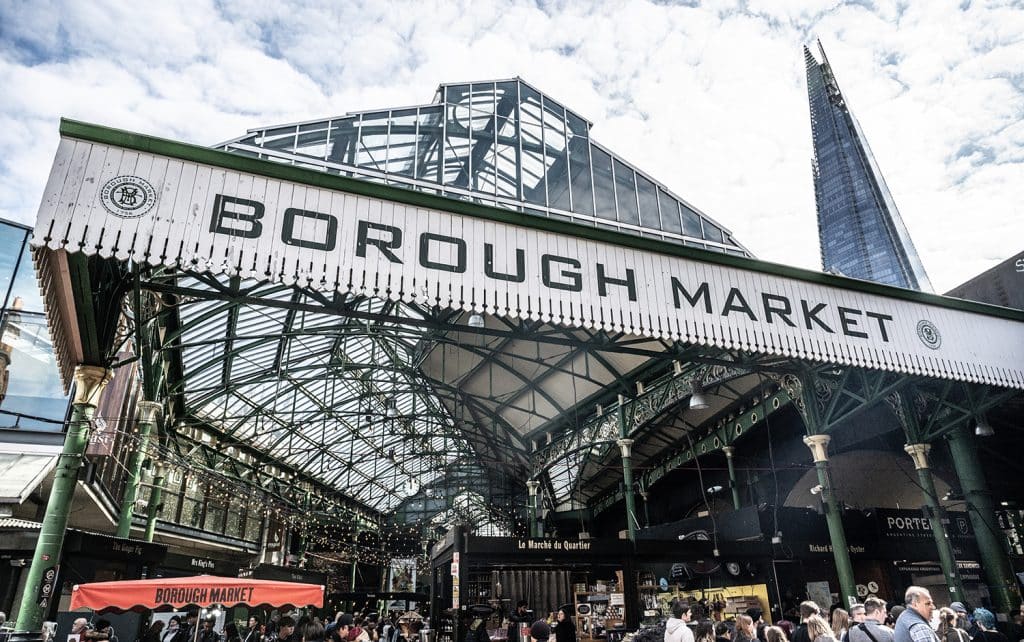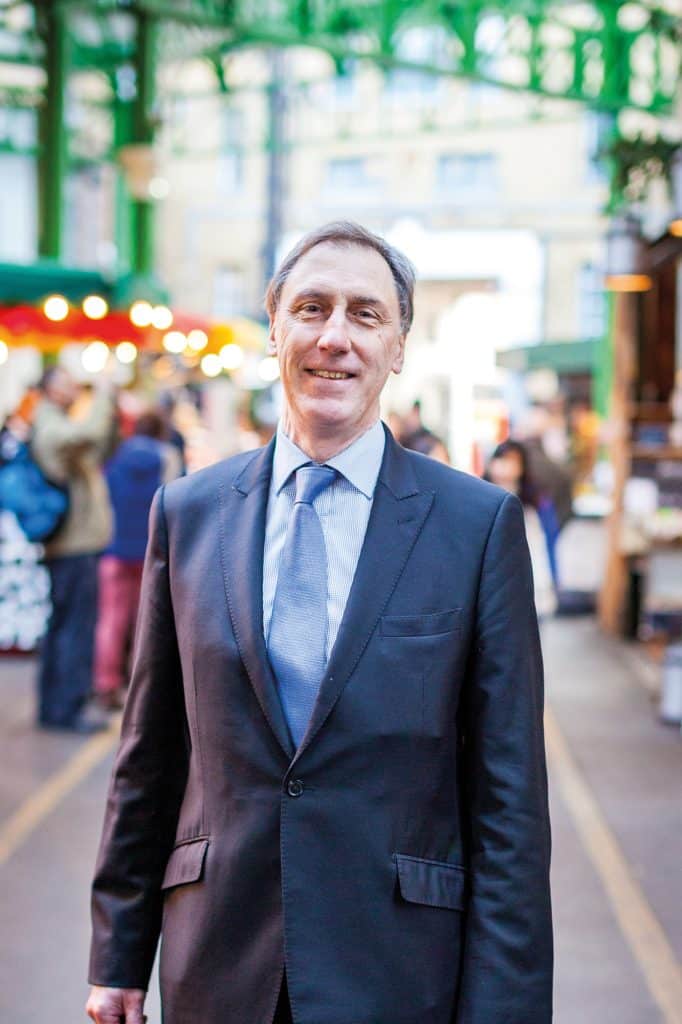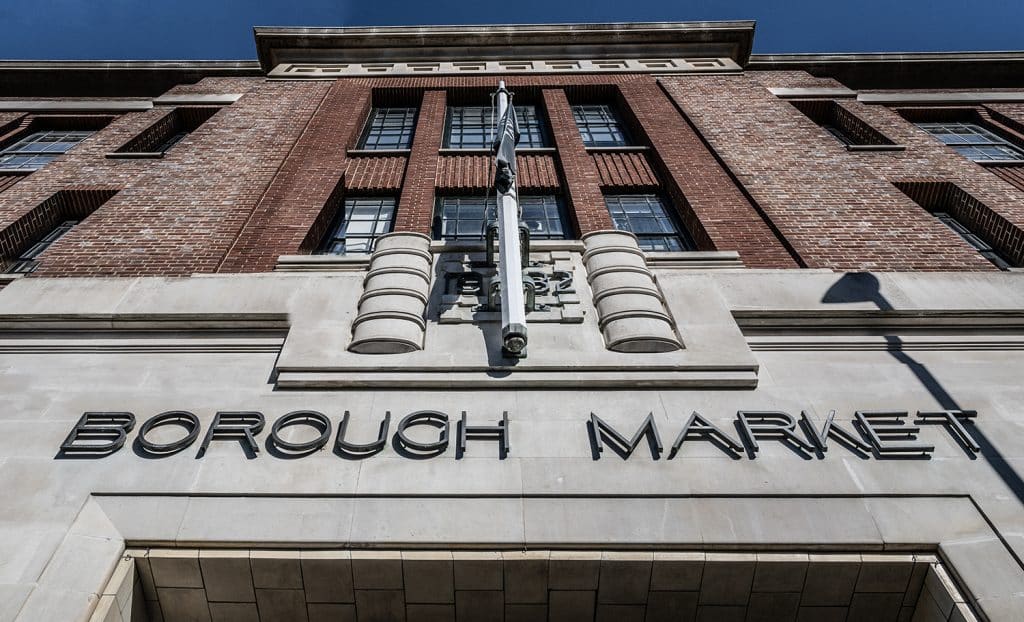A view from the chair
Adrian Bunnis, Borough Market’s outgoing chair of trustees, reflects on his 13 years at the Market and the significant changes he’s seen along the way


“IT’S IN THE REALLY DIFFICULT TIMES THAT YOU SEE HOW MUCH THIS PLACE MEANS TO PEOPLE”
Images: Sim Canetty-Clarke, John Holdship
“The history of this place makes you feel so small,” says Adrian Bunnis. “You only have to go into the boardroom and look at how many people’s names are up on the wall to see how far back it goes. It’s a reminder of how important it is that we hand it on in good shape to the next generation.”
In January, Adrian stepped down from the board of the charitable trust that runs Borough Market after four years as its chair and a total of 13 years as a trustee. And while the sheer scale of the Market’s history makes his time here seem the mere blink of an eye, there’s no questioning the significance of his contribution.
Adrian, a highly experienced surveyor and property executive, was first recruited to the charity’s Board in 2011. At the time, the trust was submerged in a complex and highly disruptive infrastructure project involving the overhead railway lines that loom over the Market, and his professional expertise was of great value in the board’s knotty dealings with Network Rail. “I came in wearing my surveyor’s hat and initially that’s all I focused on, to be honest, because that’s what I knew,” he explains.
Since then, and particularly since taking over as chair at the start of 2020, his focus has broadened significantly, as has his understanding of the Market’s unique ecosystem. “It’s a very complicated situation,” he says. “When I came on board, it took me years to get my head around it all. There are dozens of very different traders, and they all have different priorities, different perspectives on what the Market should be and what it is they want to get out of their time here. Then on top of that there’s a fantastic community that we’re a small part of, and all those people have got a view too. This place is very important to a lot of very different people. Balancing all that is a real challenge.”

Adrian’s leadership of the Board began just weeks before the onset of the first Covid lockdown, which required rapid action to shore up the Market’s finances, support ailing businesses and provide the local community with safe access to essential ingredients. Within the same highly pressurised period, it also became apparent that the Market’s governance structures needed a rapid overhaul. “The governance framework we were working to dated from when this was a wholesale market, and it wasn’t fit for purpose when it came to how we work now,” says Adrian. “Updating that was just something that needed to be done, so we commissioned a full independent review. It wasn’t easy, but I do believe that out of it has come a solid bedrock that has allowed the board to now get on and think about the future.”
The shape that future takes will to a large extent be determined by two significant documents produced by the board during Adrian’s tenure: the Borough Market Food Policy and the 2030 Strategy. The first of these, published in 2022, sets out in simple terms the fundamental principles that will inform the Market’s approach to food in years to come, covering topics such as quality, accessibility, and social, economic and environmental sustainability. In the past, people both inside and outside the Market had their own implicit understanding of what Borough Market food should be; in future, it will be there in black and white, in a way that can be properly tested and explained. It’s an important step for Borough, and one that Adrian believes will have an influence well beyond SE1: “Every time we mention our Food Policy to other big-city markets around the world, they immediately say: ‘Could you send us a copy?’”
The second document, the 2030 Strategy, recently made public after a lengthy period of consultation involving hundreds of stakeholders, clarifies what the charity’s purpose should be, summarises its ambitions in five key areas – food, place, voice, sustainability, and equity, diversity and inclusion – and sets out some of the more detailed commitments and initiatives required to achieve them. It acts as a roadmap for the Market for the remainder of the decade and leaves Shane Holland, Adrian’s successor as chair, and the rest of the Board with a clear sense of direction. “As I hang up my metaphorical Borough Market boots, I think I leave it standing in pretty good stead,” says Adrian. “There are a lot of challenges to face, but the trust is well equipped to confront them.”
He leaves here a changed man: “I’m much fussier now about what I eat, and I have much more of an appreciation about where it comes from – the impact on the planet, the welfare of the animals, the whole sustainability piece.” He also walks away with a deep admiration for a community asset whose importance shone through most vividly at the hardest of times. “Every time the place was in difficulties – the Network Rail project, the awful events of the London Bridge terror attack, the Covid pandemic – one of the things I noticed was the speed with which people stepped up and helped get it back on its feet again,” he says. “It’s at times like those that you see how much this place means to people. You see the lengths they’re prepared to go to in order to protect it. That’s why the responsibility of the trustees is such a significant one.”
Q&A: Shane Holland & Claire Pritchard
Borough Market’s new chair and vice chair on their relationship with food, their responsibilities as trustees, and their top tips for shoppers
